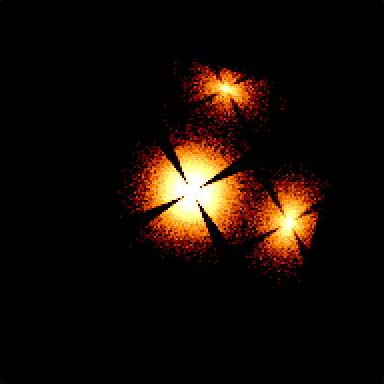XISSIM: Simulating XIS Events with xissim
Xissim simulates XIS events of faked photons generated with mkphlist, by taking the XRT efficiency and the XIS response into account. To run xissim, you need to specify the satellite Euler angles (see Step 1) and some calibration data files (XIS response and XIS OBF contamination description files).
The output FITS file contains event and GTI extensions. The current version of xissim does not consider non X-ray background, event pile-up, event grade, nor CCD exposure frames. Though the output event files contains all the columns in the FITS files of the real data, the STATUS and GRADE columns are filled with 0, while the PHA column has the same value as the PI column.
The following is the command used for simulating Eta Carinae with the XIS1 (BI chip) detector. We also input faked photon lists for the two bright sources at the top and the right (wr25.photon, hd93250.photon).xissim clobber=yes \ instrume=XIS1 ea1=161.2650 ea2=149.6845 ea3=106.0 \ infile1=etacar.photon infile2=wr25.photon infile3=hd93250.photon infile4=none \ date_obs ="2009-09-01T00:00:00" \ xis_rmffile=ae_BI_ao4_20090901.rmf \ xis_contamifile=ae_xi1_contami_20061016.fits \ outfile=xis1_etacar.evt
Make sure to specify the new contamination calibration file, as is done above.
If you choose xis_chip_select=no, the events outside the XIS FOV are also recorded in the output FITS file with the SEGMENT column at -1.
The output FITS file (xis1_etacar.evt) can be analyzed as normal data with the generic software such as xselect, ximage, xspec, and xronos
though we do not have an option to simulate an arbitrary light curve. In
the image below, the left panel shows the result of the simulation and
the right panel shows the observing image. The simulated image is too sharp (no aspect
jitter, no background), therefore the shadows of the telescope support
structures stand out more, while the observing image has the
calibration sources the the top corners. Except these features, both
images look similar!
BACK: Faking incident photons with mkphlist
UP: Xissim top page
If you have any questions concerning Suzaku, visit the Feedback form.



